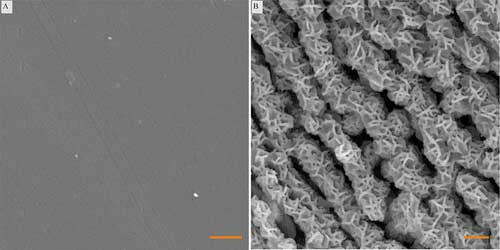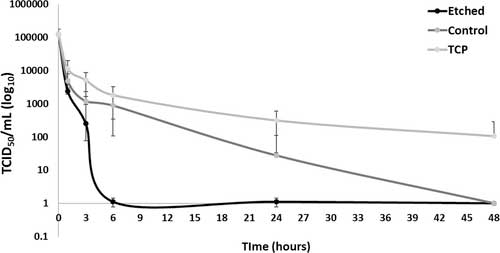| Sep 18, 2020 | |
Nanostructured surface inactivates SARS-CoV-2 coronavirus within six hours |
|
| (Nanowerk Spotlight) While the number of bacterial and viral infections has been steadily rising, the emergence of the novel Covid-19 pandemic has caused a surging demand for antimicrobial treatments that can keep surfaces clean, particularly in health care settings. However, all of these surfaces and coatings have been developed to combat bacteria but not to kill off viruses. | |
| Quite surprisingly, so far the effect of nanostructured surfaces on viruses has never been investigated. | |
| In new work reported in ACS Biomaterials Science & Engineering ("Antiviral Nanostructured Surfaces Reduce the Viability of SARS-CoV-2"), researchers from the Centre for Biomedical Technologies at Queensland University of Technology have successfully produced durable antiviral surfaces that inactivate SARS-CoV-2 within 6 hours. | |
| In contrast, on various non-nanostructured surfaces or smooth surfaces, the SARS-COV-2 virus remained viable for up to 48 hours. | |
 |
|
| Figure 1. Scanning electron micrographs of the (A) smooth control (scale bar = 1 µm) and (B) etched aluminum (scale bar = 200 nm) with nanostructured topography. (Reprinted with permission by American Chemical Society) | |
| "Our results provide evidence that surfaces that are structured with specific nanoscale surface features are effective in preventing SARS-CoV-2 and the subsequent environmental spread," Jafar Hasan, the paper's first author, tells Nanowerk. "Such nanostructured surfaces can be used in hospital environments such as with trolleys, bed-rails, door-knobs etc. These surfaces can be extended to other industrial sectors and public infrastructure such as transportation, where fomites or contaminated surfaces are carriers for viral infections." | |
| This research has grown out of earlier work (ACS Biomaterials Science & Engineering, "Antiviral and Antibacterial Nanostructured Surfaces with Excellent Mechanical Properties for Hospital Applications") where the team, led by Prof. Prasad K.D.V. Yarlagadda, showed that nanoscale topography can kill and inactivate a wide range of bacteria and viruses. | |
| "We have been working in the area of nanostructured antibacterial surfaces for many years," says Hasan. "As bacterial cells are mechanically ruptured on these surfaces, we hypothesized that if we can create nanostructures smaller than the size of viruses, then maybe we can deactivate or reduce the viability of viruses as well." | |
| For this work, the team wet-etched randomly oriented nanostructured onto an aluminum 6063 alloy surface. The nanostructures on the etched surfaces had a width of 21-25 nm and were grouped randomly in the form of parallel ridges, visible at high magnifications (see Figure 1). | |
| In their previous work, the researchers demonstrated that wet-etched Al 6063 possesses excellent antibacterial properties against Gram-positive and Gram-negative bacteria. In the same study, they also found the surfaces to be antiviral against respiratory syncytial virus and rhinovirus, in that live infectious virus was reduced within hours of exposure. | |
| Now, in their present work, they have shown for the first time the effect of nanostructured topography against SARS-CoV-2. | |
| "We found that upon exposure to the etched surface, the viability of the SARS-CoV-2 virus was reduced significantly within 6 hours compared to exposure to smooth Al control and TCP surfaces," Hasan points out. "With a 5-log reduction, there was practically no live virus recovered from the etched surfaces at 6 hours of exposure or later." | |
 |
|
| Figure 2. Viability of SARS-CoV-2 on the surfaces of the etched (nanostructured) Al 6063 alloy, control Al 6063 alloy and nonmetal surface tissue culture plates (TCP) at different time intervals of 1, 3, 6, 24, and 48 hours. The titers of viable viruses are expressed as TCID50/mL in logarithmic scale. (Reprinted with permission by American Chemical Society) | |
| "This is a novel finding which demonstrates the efficacy of nanostructured Al 6063 alloy in reducing viable SARS-CoV-2 on surfaces, thus reducing the risk of transmission by fomite contamination," Hasan concludes. "The next stage of our research is to understand the antiviral mechanism at work here and provide similar technologies to several industries. Fabrication of nanostructures on different materials and understanding the antiviral mechanism will provide further developments to fully address the issues around viral spread." | |
| The team will also explore how to upscale the technology for potential industrial-scale production. | |
 By
Michael
Berger
– Michael is author of three books by the Royal Society of Chemistry:
Nano-Society: Pushing the Boundaries of Technology,
Nanotechnology: The Future is Tiny, and
Nanoengineering: The Skills and Tools Making Technology Invisible
Copyright ©
Nanowerk LLC
By
Michael
Berger
– Michael is author of three books by the Royal Society of Chemistry:
Nano-Society: Pushing the Boundaries of Technology,
Nanotechnology: The Future is Tiny, and
Nanoengineering: The Skills and Tools Making Technology Invisible
Copyright ©
Nanowerk LLC
|
|
|
Become a Spotlight guest author! Join our large and growing group of guest contributors. Have you just published a scientific paper or have other exciting developments to share with the nanotechnology community? Here is how to publish on nanowerk.com. |
|
